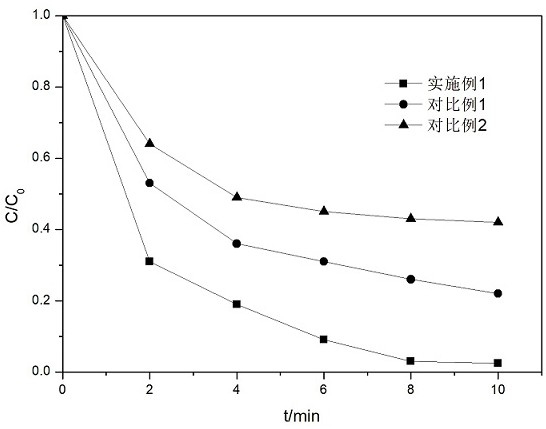A method for photocatalytic advanced treatment of papermaking wastewater
A technology for advanced treatment of papermaking wastewater, applied in chemical instruments and methods, special compound water treatment, light water/sewage treatment, etc., can solve the problem of unsatisfactory removal effect, improve the quality of recycled water, and achieve good photocatalytic performance , to promote the effect of separation
- Summary
- Abstract
- Description
- Claims
- Application Information
AI Technical Summary
Problems solved by technology
Method used
Image
Examples
Embodiment 1
[0031] A preparation method of a composite photocatalyst, comprising the following steps:
[0032] (1) MnO 2 Preparation of Nanopowder
[0033] Weigh 0.4 mol of potassium permanganate powder and 0.6 mol of manganese chloride powder, dissolve them in 60 mL of deionized water to prepare solutions, put the solutions in a water bath and heat them to 90 °C, keep them warm for 3 hours, and then separate the two solutions Apply a pulsed electromagnetic field (400W, 3Hz, 90s), then pour the manganese chloride solution into the potassium permanganate solution at a constant speed and keep stirring for 3 hours. After the reaction is complete, vacuum filter the solution, and use deionized water and anhydrous Repeated washing with ethanol to remove impurity ions, put the obtained product in a drying oven at 80 °C for 14 hours to constant weight, and then fully grind it with an agate mortar to obtain MnO 2 Nano powder; the MnO 2 The particle size range of nano powder is 6nm;
[0034] (2...
Embodiment 2
[0041] A preparation method of a composite photocatalyst, comprising the following steps:
[0042] (1) MnO 2 Preparation of Nanopowder
[0043] Weigh 0.4mol of potassium permanganate powder and 0.6mol of manganese nitrate powder, dissolve them in 60mL of deionized water to prepare solutions, put the solutions in a water bath and heat them to 80°C, keep them warm for 4h, and then apply to the two solutions respectively Pulse electromagnetic field (400W, 3Hz, 90s), then pour the manganese chloride solution into the potassium permanganate solution at a constant speed and stir continuously for 1h, after the reaction is complete, vacuum filter the solution, and use deionized water and absolute ethanol Repeated cleaning to remove impurity ions, put the obtained product in a drying oven at 70 °C for 16 hours to constant weight, and then fully grind it with an agate mortar to obtain MnO 2 Nano powder; the MnO 2 The particle size range of nano powder is 12nm;
[0044] (2) MnO 2 Pr...
Embodiment 3
[0051] A preparation method of a composite photocatalyst, comprising the following steps:
[0052] (1) MnO 2 Preparation of Nanopowder
[0053] Weigh 0.4mol potassium permanganate powder and 0.6mol manganese acetate powder, dissolve them in 60mL deionized water to prepare solutions, put the solutions in a water bath and heat to 100°C, keep warm for 1h, and then apply to the two solutions respectively Pulse electromagnetic field (400W, 3Hz, 90s), then pour the manganese chloride solution into the potassium permanganate solution at a constant speed and stir continuously for 4 hours. After the reaction is complete, vacuum filter the solution, and use deionized water and absolute ethanol Repeated cleaning to remove impurity ions, put the obtained product in a drying oven at 90 °C for 12 hours to constant weight, and then fully grind it with an agate mortar to obtain MnO 2 Nano powder; the MnO 2 The particle size range of nano powder is 8nm;
[0054] (2) MnO 2 Preparation of @...
PUM
| Property | Measurement | Unit |
|---|---|---|
| particle diameter | aaaaa | aaaaa |
| particle diameter | aaaaa | aaaaa |
| particle diameter | aaaaa | aaaaa |
Abstract
Description
Claims
Application Information
 Login to View More
Login to View More - R&D
- Intellectual Property
- Life Sciences
- Materials
- Tech Scout
- Unparalleled Data Quality
- Higher Quality Content
- 60% Fewer Hallucinations
Browse by: Latest US Patents, China's latest patents, Technical Efficacy Thesaurus, Application Domain, Technology Topic, Popular Technical Reports.
© 2025 PatSnap. All rights reserved.Legal|Privacy policy|Modern Slavery Act Transparency Statement|Sitemap|About US| Contact US: help@patsnap.com

